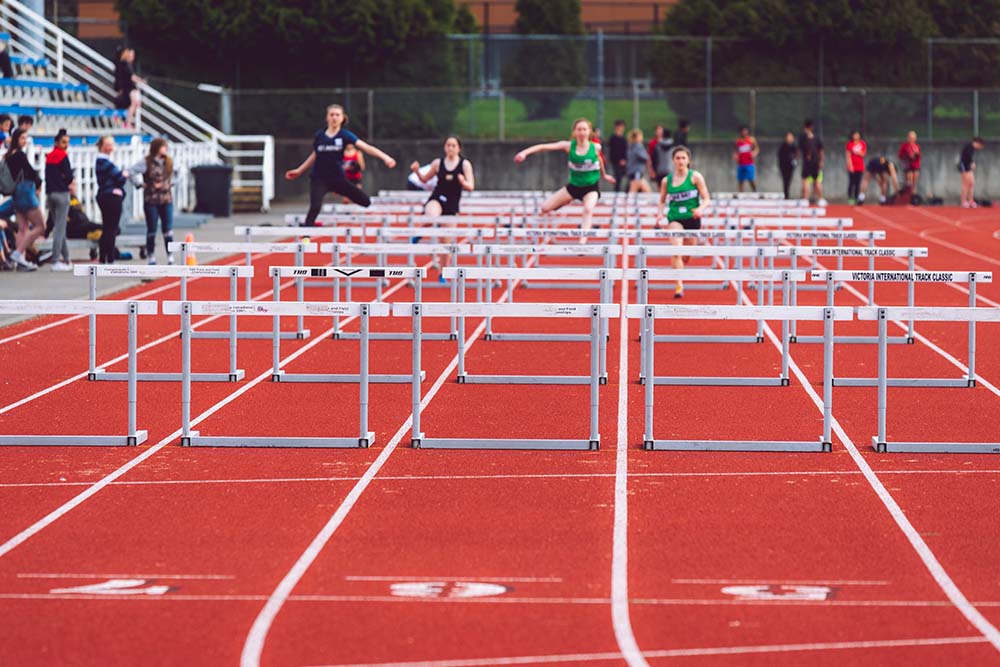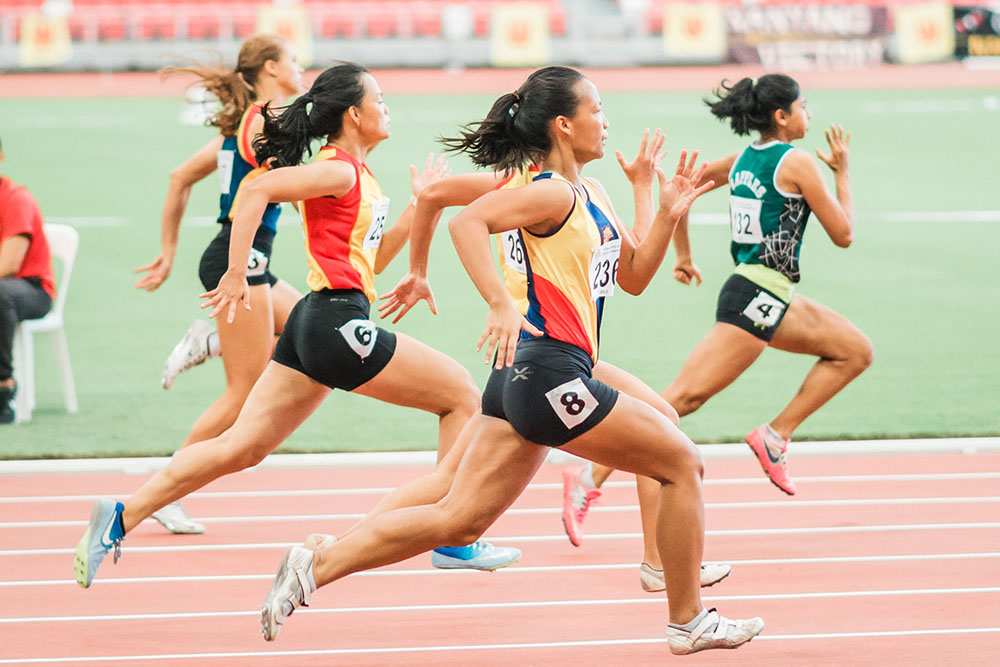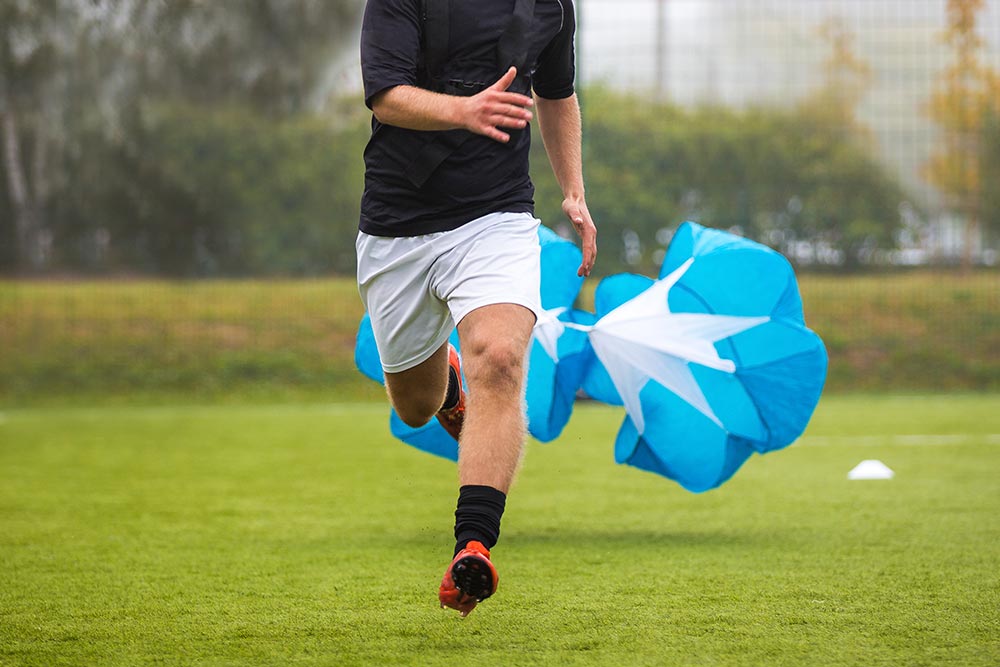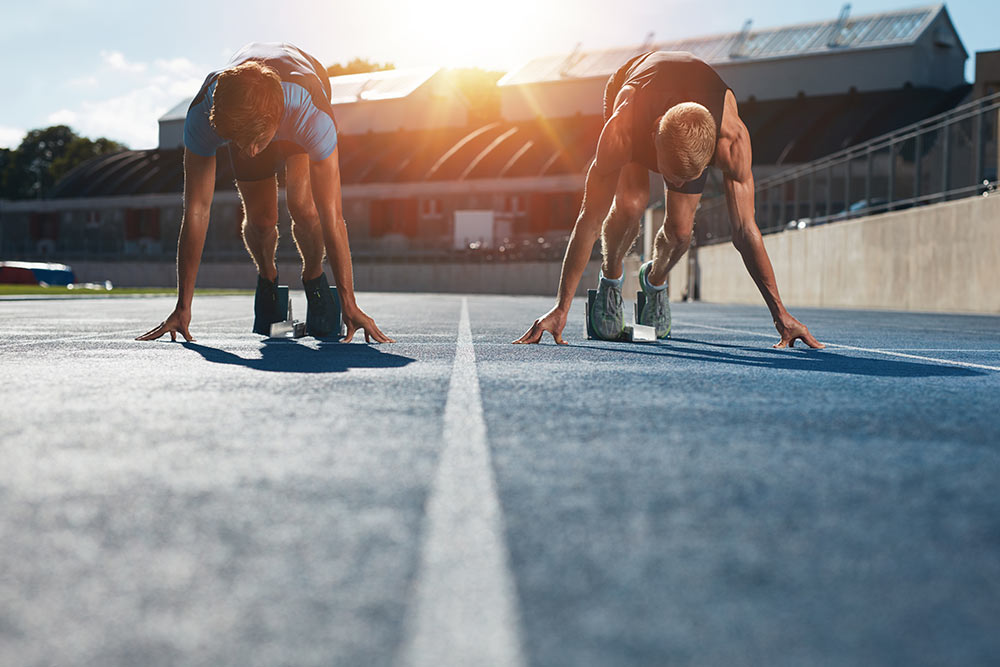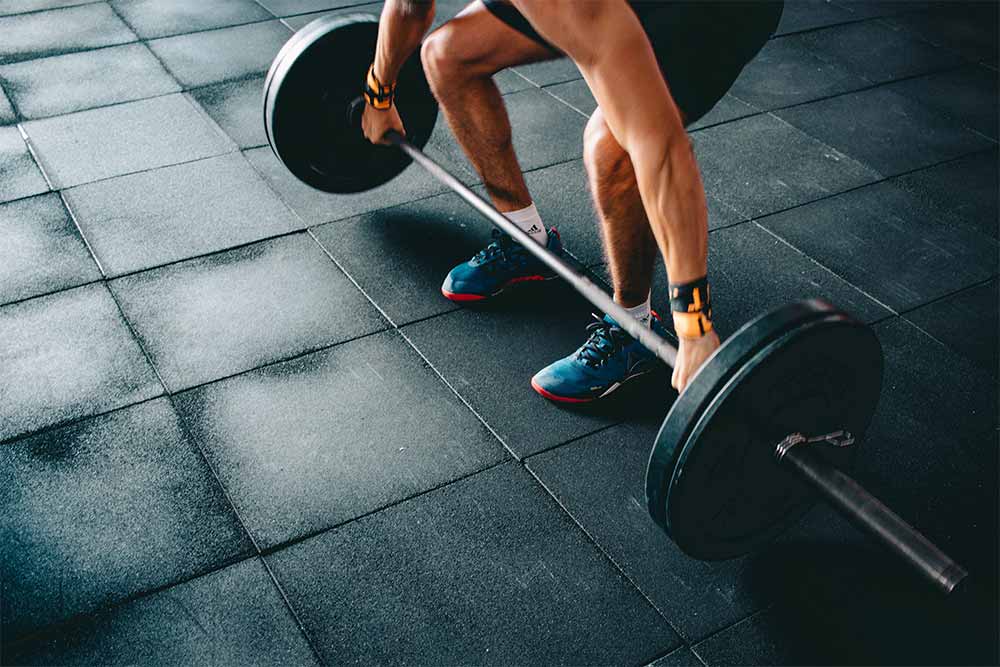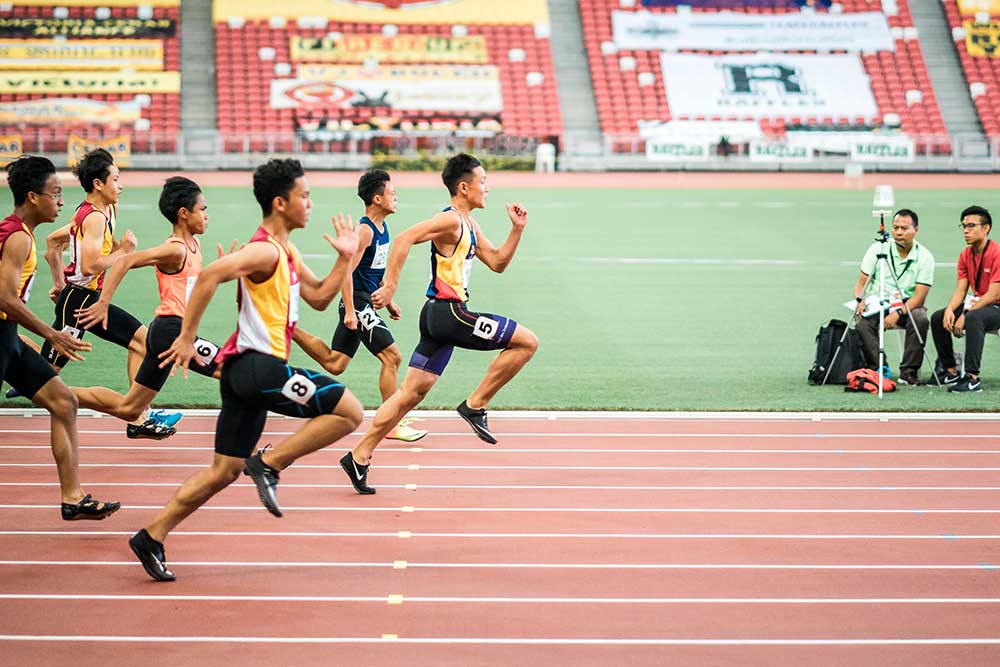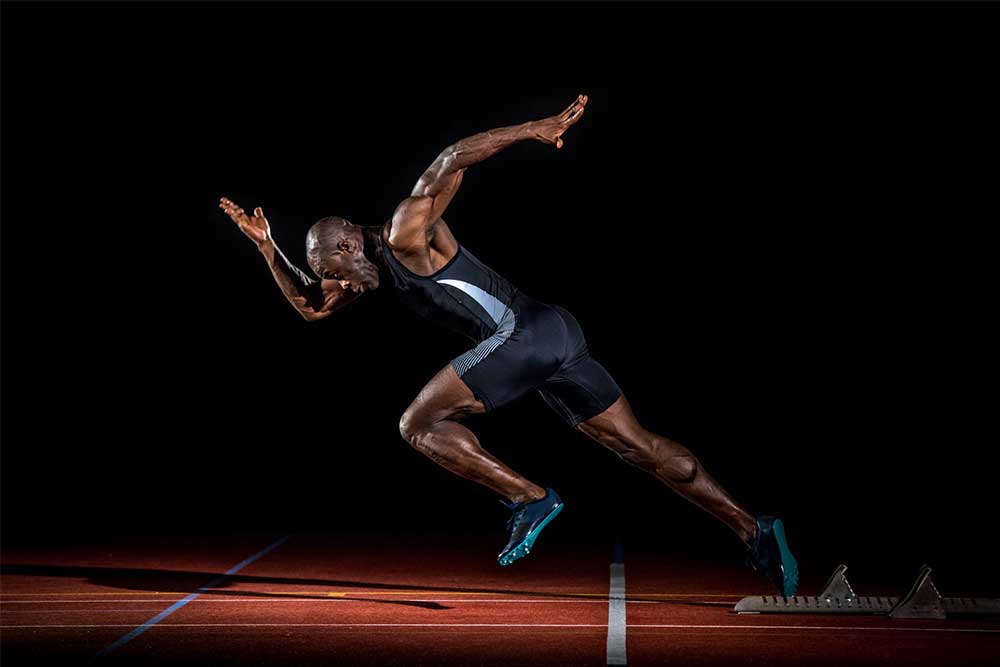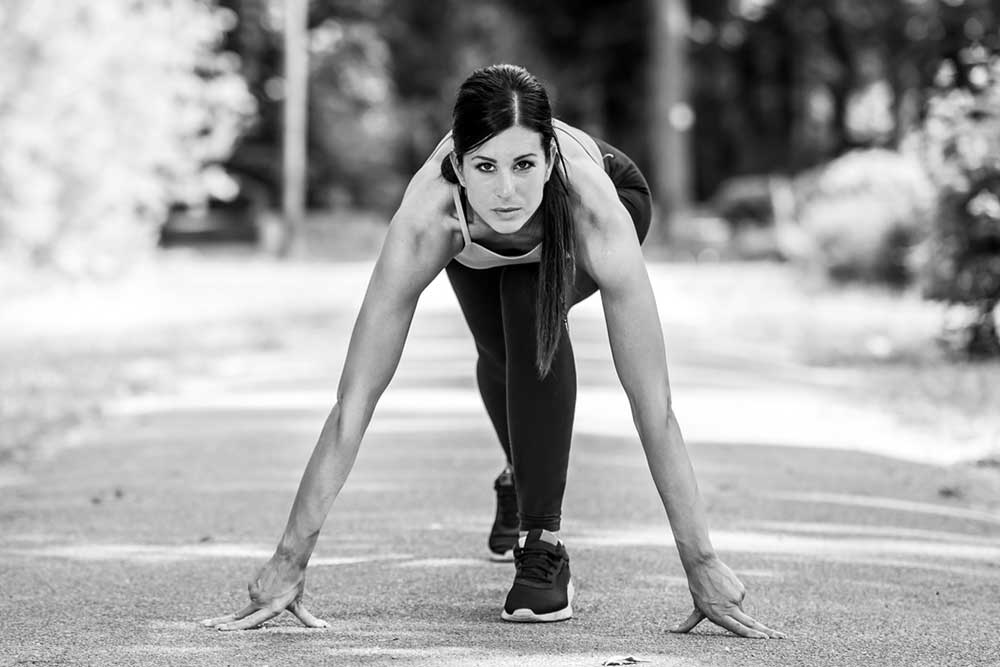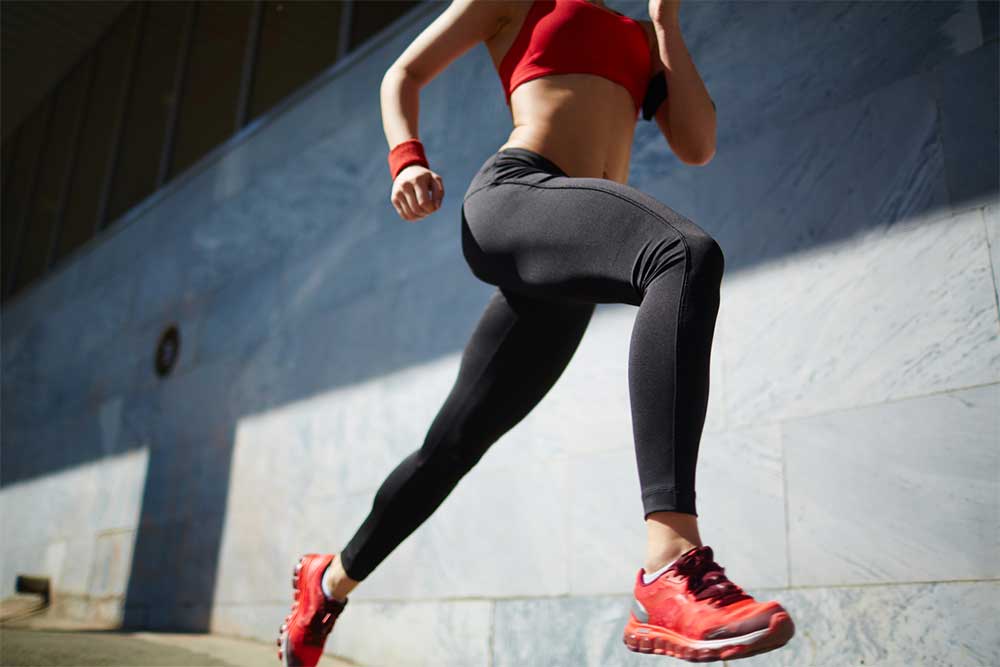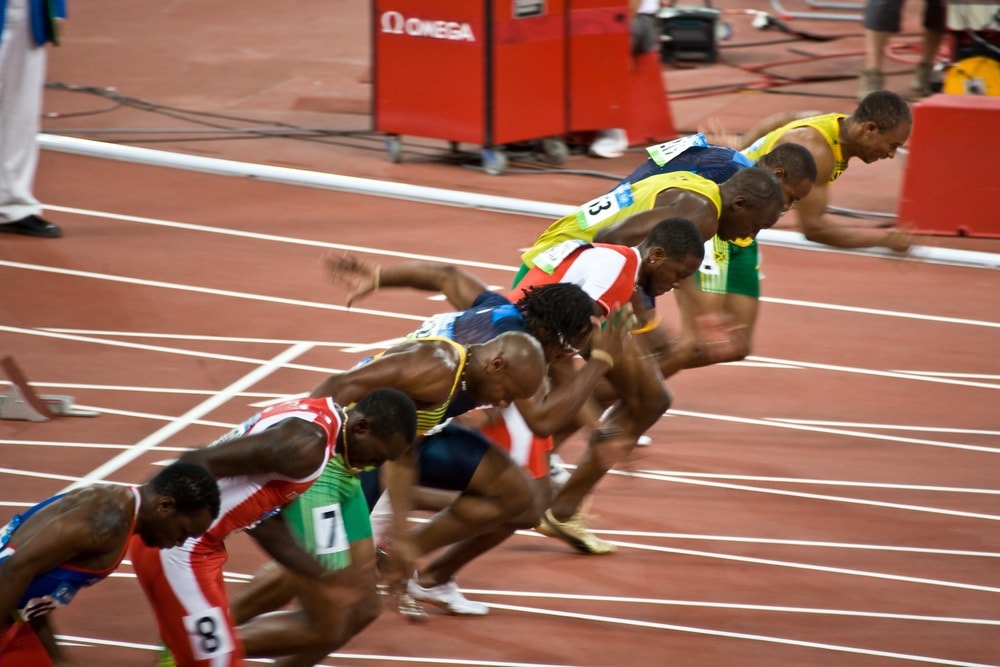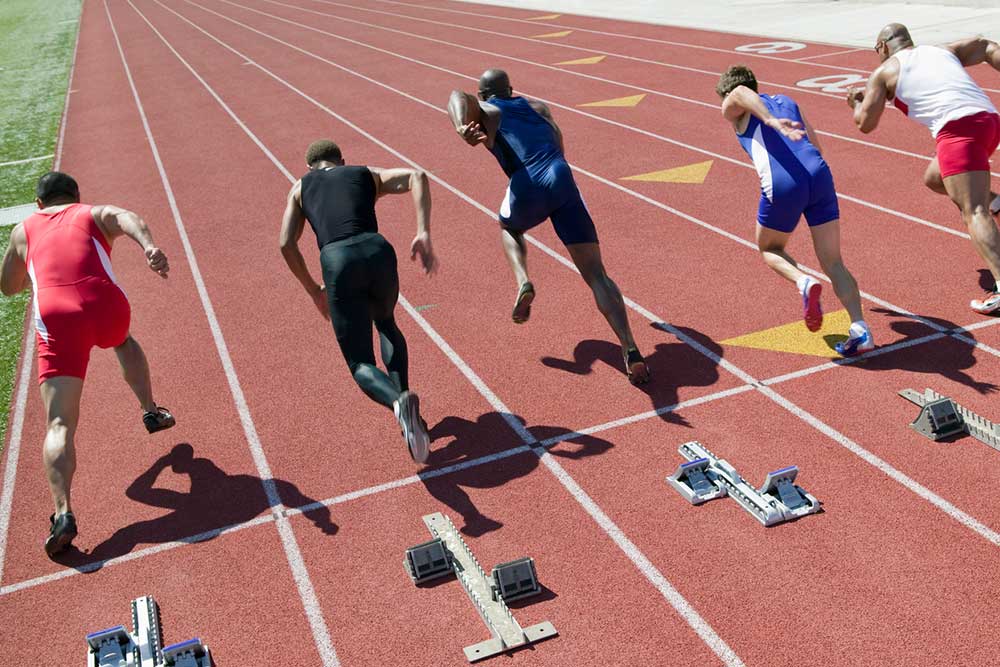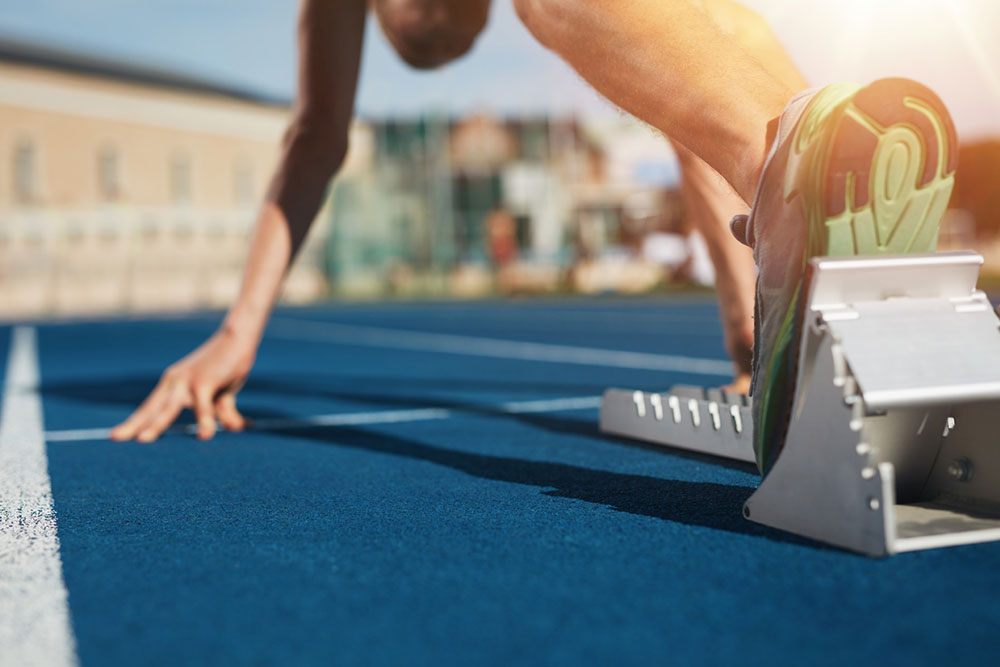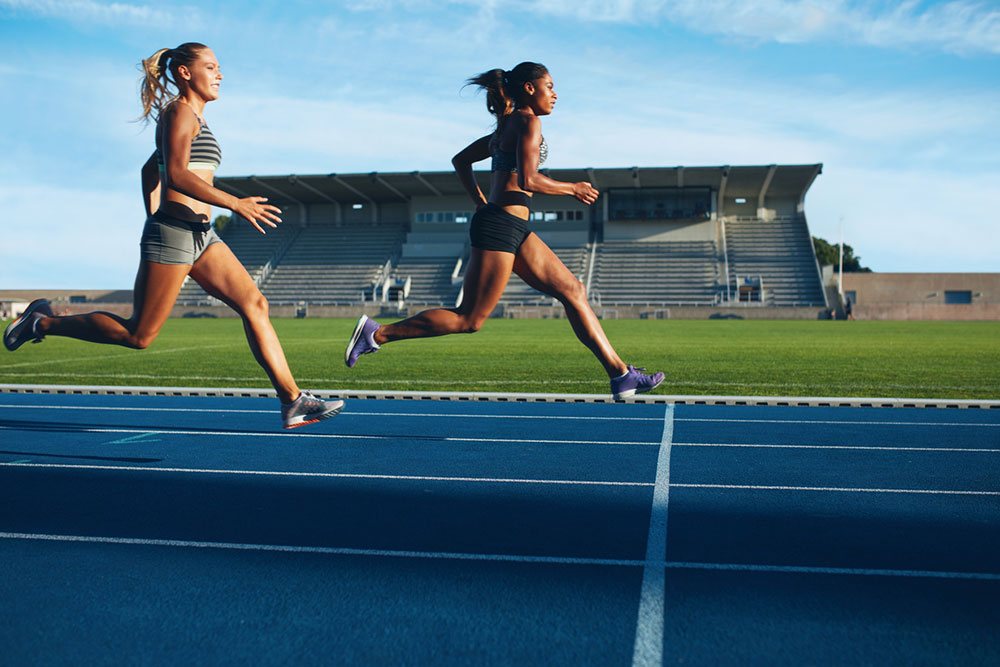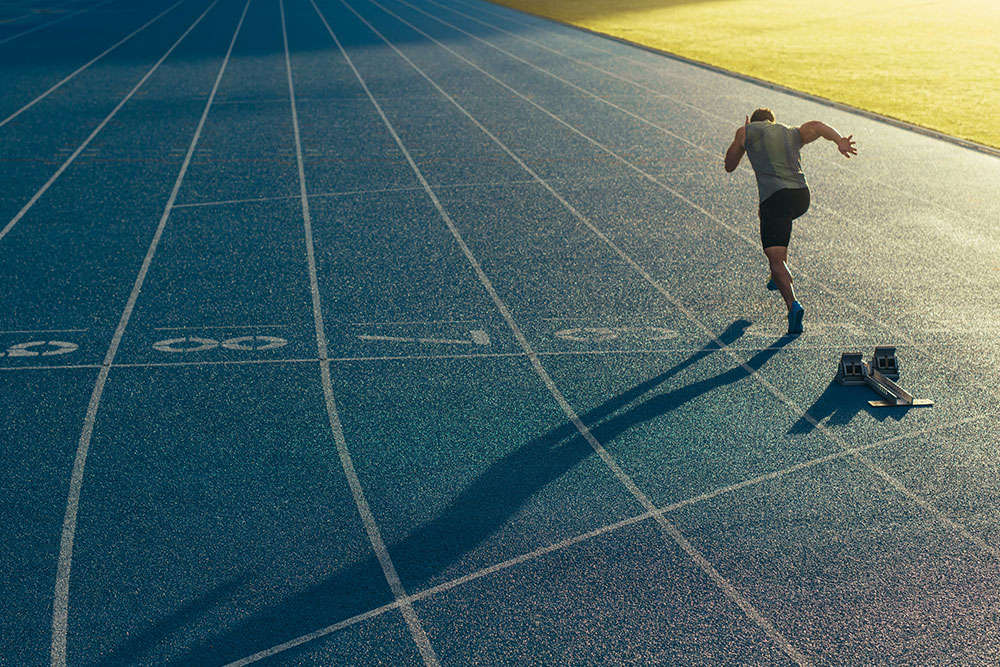The Biomechanics of the Sprint Start

A perfect sprint performance is dictated by several factors, including muscle strength, explosive muscle power, a high degree of neural coordination, and most importantly – optimal sprinting technique.
However, while most sprinters tend to take an in-depth look at their sprinting technique when they are at maximal speed, they overlook what I would consider to be one of the most important components.
Yep, you guessed it – the sprint start.
The key points of sprint start technique
Before I delve into the tips for faster sprint starts, I wanted to take the time to outline key points associated with optimal sprint start technique – which, as many of you would know, can be broken down into three distinct phases (Bezodis, 2019).
On your mark position
The first phase we look at is the on your mark position – which, as its name so aptly suggested, occurs when you hear those three important words spoken aloud. This integral position is all about maintaining good body position while you are in the blocks.
It is this position that ensures you can develop maximal explosive power at takeoff.
To maximize the on your mark position, you want to make sure of the following:
- The thigh of your back leg should be perpendicular to the ground.
- Your front shin should be parallel to the ground.
- Arms should be kept straight and held slightly wider than the width of your shoulders.
- In this position, your shoulders should be slightly over your hands.
- Your head and neck should be relaxed and aligned with the rest of your spine.
- Eyes should be looking intently at the ground directly below you.
- Finally, your hands should form a bridge with your fingers spread.
Get set position
From here, you transition into the get set position.
With this position, you are essentially setting yourself up for an explosive forward movement. As a result, you need to follow the points below perfectly to ensure you do not waste any energy and lose any speed.
As you hear the words ‘get set’, you need to make the following transitions.
- Your hips should rise slowly.
- Your shoulders should remain in the same position.
- Push your whole foot back against the block.
- In this manner, your legs should be positioned to drive you forward (rather than up).
- Front leg should be angled at 90-100 degrees.
- Back leg should be angled at 120-135 degrees.
- Your eyes should remain looking down at the ground.
Gun position
And then the gun goes off – and this is known as the gun position.
Optimizing the gun position means that as you push off, your strides will become longer, and you will place more force into the ground each step. Consequently, both your start speed will improve, as will the rate at which you reach top speed.
To optimize the gun position, you want to make sure of the following.
- Push both feet off the blocks simultaneously and drive yourself out as far as you can.
- Your rear leg should extend fully at the hip, knee, and ankle.
- The angle of your body should be 45 degrees and leaning forward.
- Your knees should drive up aggressively.
- Pump your arms as fast as possible.
- Your eyes should be focused 5 meters in front of you.
I should note that as you exit the acceleration phase of the sprint (which is driven by the gun position), you should slowly raise your head until you are running tall and in an upright position. It is this that will enhance your transition into top speed.
Female vs Male Sprinters
As you would very much be aware, there are some significant differences between the physical and biomechanical makeup of males and females. Consequently, you might be wondering if these differences cause any changes in the start positions of male and female sprinters?
Fortunately for us, there has been some rather interesting research into the area that has shown that there is only really a couple of clear differences between male and female sprinters in this manner.
Research has shown time and time again that males take less time to push themselves from the blocks after the gun has gone off than female athletes. This corresponds with a significantly higher block exit velocity, and results in shorter contact times for the first two steps out of the blocks.
All of which contribute to faster acceleration.
It is important to note that while this difference has been observed time and time again, it appears to remain consistent at all levels of performance. As a result, it is not likely to be related to technique, but rather to strength.
See, as a general rule of thumb, males tend to have better absolutely strength capacity than females. This means that they can create more force coming out of the blocks, which results in a faster exit velocity.
Quite a simple explanation really.
Fortunately, this gives us a little bit of insight into the benefits of strength and power training for sprint athletes – but more on that later!
Junior vs Senior sprinters
We have touched on the small differences between males and females, but what about junior and senior sprinters? How does experience impact sprint take off?
Interestingly, both male and female senior sprinters demonstrate significantly longer first step lengths than their junior counterparts. As a result, they also reach markedly higher speeds over the first five meters of their sprint.
This is thought to come down to the fact that younger sprinters are unable to generate as much knee joint power during the gun phase of sprinting. This again could very well be a result of limited strength, which is obviously something that gets addressed with training.
The Importance of horizontal force production
Before I get into the best way to implement training (or as I have already alluded to, strength and power training) for sprinters, I wanted to touch on a thing known as horizontal force production.
So, what is horizontal force production?
To keep it simple, it refers to force being produced in a horizontal direction.
For example, during sprinting, you place force into the ground with each step. If you were simply applying a vertical force, you would move straight up in the air (as you would with a vertical jump). However, as you are also applying a horizontal force, you also propel yourself forward.
Now, in terms of sprinting – or rather, sprint starts specifically – good horizontal force production is paramount.
See, the more horizontal force you can produce during your sprint start, the greater your acceleration becomes out of the blocks. This means that you will achieve your top speed faster, ultimately resulting in better sprint performance.
There is a very good reason that research has shown that high level sprinters can produce horizontal forces of around 1.3 time their bodyweight as they push out of the blocks during the gun phase – because it is essential as you become a better sprinter!
Training to improve horizontal force production
When it comes to training to improve your horizontal force production, a combination of strength and power-based exercise are essential.
However, not just any exercises will do.
These exercises need place a huge emphasis on the muscles of the posterior chain (think glutes and hamstrings). Moreover, they also need to have your produce force in a horizontal fashion, rather than in a vertical one.
So, without further ado – the best exercises for faster sprint starts.
The best exercises to improve the sprint start
Taking the above into consideration, I have outlined my three favorite exercises to maximize horizontal force production and take your sprint start to the next level.
The Bounding Broad Jump
 The broad jump itself is a fantastic exercise that helps develop explosive horizontal power. However, by implementing it in a bounding manner, it also increases your ability to use the stretch shortening cycle, which will reduce the ground contact times of your first few steps out of the blocks (Gjinovci, 2017).
The broad jump itself is a fantastic exercise that helps develop explosive horizontal power. However, by implementing it in a bounding manner, it also increases your ability to use the stretch shortening cycle, which will reduce the ground contact times of your first few steps out of the blocks (Gjinovci, 2017).
The bounding broad jump is performed as follows:
- Start by standing with your feet set shoulder width apart, and with your arms up in the air.
- Commence the exercise by snapping your arms down and back behind your body, as you simultaneously bend your knees and push your hips back towards the wall behind you.
- Then swing your arms forward as you drive your feet into the ground, snap your hips forward, and jump as far forward as you can.
- Land on your feet and rapidly drop back down into the starting position, before transitioning immediately into another jump.
The bounding broad jump is best performed for 3-5 sets of 3-5 repetitions at the start of your workout.
Heavy Sled Training
 Sled training is essentially a modality of resisted sprinting where you sprint at maximal intensity with a sled dragging behind you. The sled is most commonly attached to your torso via a harness, in which it does not restrict arm or leg movement.
Sled training is essentially a modality of resisted sprinting where you sprint at maximal intensity with a sled dragging behind you. The sled is most commonly attached to your torso via a harness, in which it does not restrict arm or leg movement.
This type of training essentially overloads the sprinting movement, in which you are required to produce more horizontal propulsive force than you would under normal circumstances. However, it was traditionally believed that sled training was best implemented using lighter loads, so it did not alter sprinting technique.
Interestingly, recent research has shown that this is not the case at all (Morin, 2017).
Implementing heavy resisted sled training using loads that equate to 80% of your body weight has been shown to cause marked improvements in acceleration, take off speed, and both 5 meter and 20-meter sprint times.
The key here is to perform 8-10 twenty-meter sprints after your broad jumps, twice per week.
Regarding performing the sprints, it is actually very simple:
- Start by lining up in a normal sprint position with the harness attached around your torso.
- Sprint as fast as you can for twenty meters.
- Rest for 2-3 minutes and repeat 8-10 times.
See, simple.
Barbell Hip Thrust
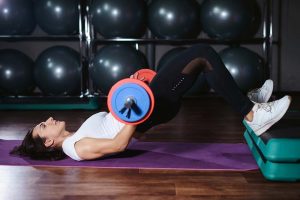 Finally, we have the barbell hip thrust.
Finally, we have the barbell hip thrust.
The barbell hip thrust is a horizontally loaded exercise that directly trains your ability to produce force at the hips in a horizontal manner. Importantly, during the barbell hip thrust, the load placed on your posterior chain becomes greatest at lockout – during a position of full hip extension (Contreras, 2017).
This very accurately meets the needs of full hip extension when you explode out of the blocks during the gun phase.
The best way to perform a hip thrust is as follows:
- First thing is to set up the barbell, so it is setting parallel to the bench.
- Sit yourself on the floor with a foam pad on your lap, with your shoulders and shoulder blades pressing against the bench (if your upper back doesn’t reach bench when you are sitting, you can raise your butt a little bit off the floor by driving your feet into the ground).
- Roll the barbell towards you (it should be sitting directly over your hips)
- Place your elbows on the bench behind you and grab the bar firmly to steady it.
- Inhale deeply, keep your chin down towards your chest, and brace your abs hard.
- Drive your heels into the ground and squeeze your glutes as hard as possible to thrust your hips (and the barbell) straight up.
- Pause for a split second in the top position, and focus on contracting your glutes as hard as you can. Your chin should still be tucked to your chest.
- Gradually lower the bar back to the floor, and then repeat for the set number of repetitions.
These guys are best performed at the start of your lower body gym day. I recommend 3-5 sets of 3-6 repetitions – and remember, make sure to complete every single rep as explosively as possible.
Take Home Message
Optimizing your sprint start is integral to maximizing your sprint performance. In short, the faster you can come out of the blocks, the faster you reach top speed – which ultimately means the faster you complete your sprint.
Using the exercises outline in this article you can cause some huge improvements in your sprint start speed – so give them a go and make sure to let us know what you think!
References
Bezodis, Neil Edward, Steffen Willwacher, and Aki Ilkka Tapio Salo. “The Biomechanics of the Track and Field Sprint Start: A Narrative Review.” Sports Medicine (2019): 1-20.
Gjinovci, Bahri, et al. “Plyometric training improves sprinting, jumping and throwing capacities of high level female volleyball players better than skill-based conditioning.” Journal of sports science & medicine 16.4 (2017): 527.
Morin, Jean-Benoît, et al. “Very-heavy sled training for improving horizontal-force output in soccer players.” International journal of sports physiology and performance 12.6 (2017): 840-844.
Contreras, Bret, et al. “Effects of a six-week hip thrust vs. front squat resistance training program on performance in adolescent males: a randomized controlled trial.” Journal of strength and conditioning research 31.4 (2017): 999-1008.
You Might Like:

